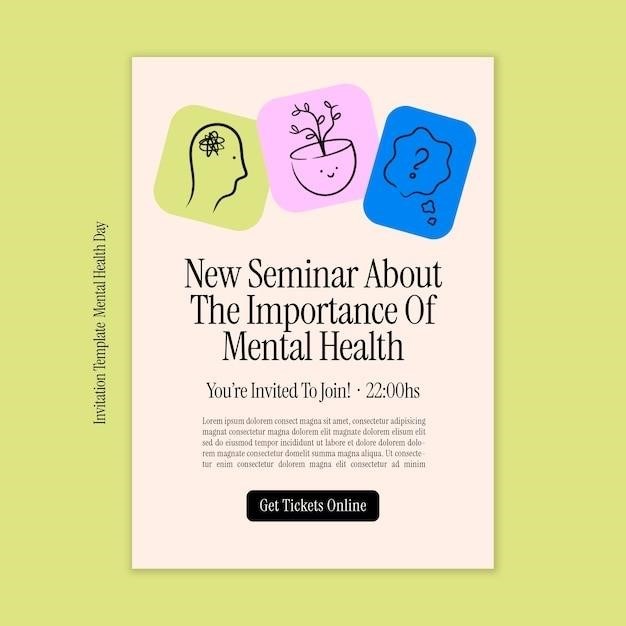Understanding Emotional Sobriety
Emotional sobriety, a crucial aspect of recovery, involves managing emotions without letting them dictate actions. It’s not about suppressing feelings but about developing healthy coping mechanisms. This contrasts with solely focusing on physical sobriety, addressing the underlying emotional issues that contribute to substance abuse. Worksheets provide a structured approach to understanding and managing emotions, promoting long-term well-being and relapse prevention.
Defining Emotional Sobriety
Emotional sobriety transcends mere abstinence from substances; it’s a profound journey of self-discovery and emotional regulation. It’s about cultivating a mindful awareness of your feelings, accepting them without judgment, and responding to them in healthy ways. Unlike physical sobriety, which focuses on ceasing substance use, emotional sobriety delves into the root causes of addictive behaviors, addressing the underlying emotional vulnerabilities that often trigger relapse. This involves identifying emotional triggers—both positive and negative—that may lead to cravings or unhealthy coping mechanisms. The goal is not to eliminate emotions, but to learn to navigate them effectively, fostering a sense of emotional balance and resilience. Worksheets serve as valuable tools in this process, guiding individuals to explore their emotional landscape, develop coping strategies, and track their progress toward sustained emotional well-being.
Emotional Sobriety vs. Physical Sobriety
While often intertwined, emotional and physical sobriety represent distinct yet complementary aspects of recovery. Physical sobriety focuses on abstaining from alcohol or drugs, marking a crucial first step. However, simply ceasing substance use doesn’t automatically address the underlying emotional issues that fuel addiction. Emotional sobriety, therefore, goes deeper, targeting the emotional patterns and vulnerabilities that contribute to substance dependence. It involves developing emotional intelligence, learning to identify and manage intense emotions without resorting to substance use as a coping mechanism. Worksheets can facilitate this process by helping individuals pinpoint emotional triggers, explore healthier coping strategies, and track their progress in managing emotions effectively. True lasting recovery often necessitates both physical and emotional sobriety, working synergistically to achieve holistic well-being.

Utilizing Emotional Sobriety Worksheets
Emotional sobriety worksheets offer a practical, structured approach to self-reflection and behavior modification. They guide users toward identifying triggers, developing coping skills, and tracking progress for sustained recovery.
Identifying Emotional Triggers
Many worksheets begin by prompting reflection on past experiences. Users are guided to pinpoint specific situations, events, or even thoughts that have historically triggered cravings or unhealthy coping mechanisms. This process involves detailed journaling, examining the emotional state preceding substance use or relapse. Worksheets might include prompts like “Describe a recent situation where you felt the urge to use,” or “What emotions were you experiencing?”. The goal isn’t simply identifying negative triggers; worksheets also encourage exploring positive triggers – situations or feelings initially associated with substance use that now present potential relapse risks. By meticulously documenting these triggers, users gain self-awareness, enabling them to anticipate and proactively manage their emotional responses in high-risk situations. The worksheets often incorporate techniques like mood tracking or emotional scales to quantify and visualize patterns in emotional responses. This detailed self-assessment is a cornerstone of effective relapse prevention.
Developing Coping Mechanisms
Once emotional triggers are identified, worksheets guide users toward developing healthier coping strategies. These strategies move beyond simple avoidance; they encourage proactive engagement with challenging emotions. Common techniques include mindfulness exercises, such as deep breathing or meditation, to regulate emotional responses in stressful situations. Worksheets may also incorporate cognitive restructuring techniques, helping users challenge negative thought patterns that contribute to substance use. For instance, a worksheet might prompt users to identify and reframe negative self-talk. Furthermore, many worksheets promote the development of a support network. Users are encouraged to list trusted individuals they can contact during moments of vulnerability, promoting social support as a vital coping mechanism. The worksheets often involve creating a personalized “coping skills toolkit,” a readily accessible list of strategies tailored to individual needs and preferences, ensuring practical application and long-term efficacy.
Tracking Progress and Relapse Prevention
Effective emotional sobriety worksheets incorporate a system for monitoring progress and preventing relapse. Regular self-assessment becomes a key component, often involving daily or weekly check-ins. Users might track their emotional state, noting triggers, coping strategies used, and their effectiveness. This data visualization helps identify patterns and areas needing improvement. Many worksheets include relapse prevention planning, encouraging users to anticipate high-risk situations and proactively develop strategies to navigate them. This might involve identifying potential triggers and creating detailed coping plans for each. Furthermore, worksheets frequently incorporate a section for reflecting on successes and challenges. This reflective practice fosters self-awareness and allows for adjustments to coping strategies as needed. By documenting progress and setbacks, users gain valuable insight into their emotional landscape, strengthening their ability to maintain emotional sobriety and prevent future relapses.
Resources for Emotional Sobriety Worksheets
Numerous resources offer free printable worksheets and comprehensive workbooks to guide individuals on their journey toward emotional sobriety. These tools provide structured exercises and helpful strategies for managing emotions effectively.
Free Online Worksheets and Templates
The internet provides a wealth of free emotional sobriety worksheets and templates. Many websites dedicated to recovery and mental wellness offer downloadable PDFs, often featuring exercises designed to identify emotional triggers, develop coping mechanisms, and track progress. These resources are readily accessible and can be a valuable starting point for individuals seeking to improve their emotional regulation skills. Some websites may offer specialized worksheets tailored to specific needs, such as those focused on managing anger, anxiety, or dealing with cravings. Remember that while these free resources are helpful, they may not be a substitute for professional guidance. Always consult with a healthcare professional or therapist for personalized support and treatment plans. The availability of these free tools, however, makes self-guided exploration and initial steps towards emotional well-being more attainable. Look for reputable sources and ensure the information aligns with your personal needs and goals. Using these worksheets alongside professional support can enhance the effectiveness of your emotional sobriety journey.
Workbooks and Guides
Beyond individual worksheets, comprehensive workbooks and guides offer a structured approach to achieving emotional sobriety. These resources often delve deeper into the underlying causes of emotional dysregulation and provide a more holistic framework for recovery. Workbooks may include a series of exercises, journaling prompts, and self-assessment tools designed to help individuals identify their emotional patterns, develop coping skills, and build a support system. Many guides incorporate principles of cognitive behavioral therapy (CBT) or dialectical behavior therapy (DBT), offering evidence-based strategies for managing emotions and preventing relapse. Some workbooks focus specifically on the 12-step program, integrating emotional sobriety principles into the recovery process. The structured format of workbooks and guides can be particularly beneficial for individuals who prefer a more comprehensive and organized approach to self-improvement. Choosing a workbook or guide that aligns with your personal needs and recovery style is crucial for maximizing its effectiveness. Consider factors like the author’s credentials, the workbook’s focus, and the overall structure to ensure a good fit.

Further Exploration of Emotional Sobriety
Beyond worksheets, consider therapy, support groups, and holistic approaches like mindfulness or yoga for comprehensive emotional well-being and sustained recovery from addiction.
The Role of Therapy and Support Groups
Therapy provides a structured environment to delve into the root causes of emotional instability, often uncovering past traumas or unhealthy coping mechanisms that fuel addictive behaviors. A therapist can equip individuals with evidence-based techniques for emotional regulation, stress management, and relapse prevention. Cognitive Behavioral Therapy (CBT) and Dialectical Behavior Therapy (DBT) are particularly helpful. Support groups, such as those offered by Alcoholics Anonymous (AA) or other recovery programs, offer a sense of community and shared experience. The peer support and shared journey of recovery offer invaluable encouragement and accountability. These groups create a safe space for vulnerability, reducing feelings of isolation and fostering a sense of belonging. Regular attendance helps solidify coping skills and reinforces the commitment to long-term sobriety. The combined benefits of therapy and support groups create a powerful synergy in achieving and maintaining emotional sobriety.
Holistic Approaches to Emotional Well-being
Holistic approaches to emotional well-being recognize the interconnectedness of mind, body, and spirit. These methods extend beyond traditional therapy and support groups, incorporating practices like mindfulness meditation, yoga, and spending time in nature. Mindfulness helps cultivate present moment awareness, reducing reactivity to emotional triggers. Yoga combines physical postures, breathing techniques, and meditation to promote relaxation and stress reduction. Connecting with nature offers a calming influence, reducing anxiety and promoting a sense of peace. Furthermore, incorporating healthy lifestyle choices, such as regular exercise, balanced nutrition, and sufficient sleep, significantly impacts emotional regulation. These holistic practices support overall well-being, creating a foundation for emotional resilience and reducing the likelihood of relapse. A balanced approach that integrates these practices with professional support enhances the effectiveness of emotional sobriety.
